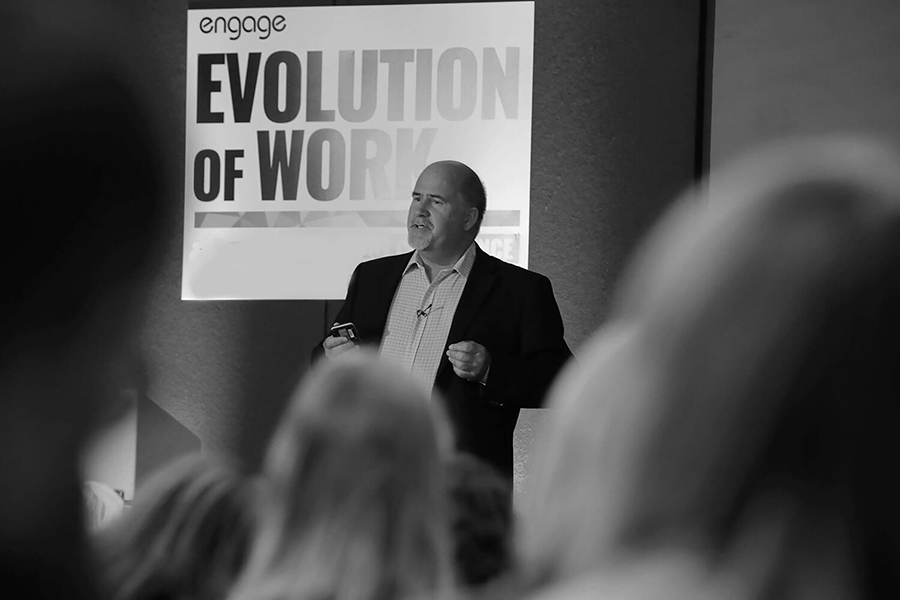Value-driven organizations where leaders communicate persuasively, both online and offline, are in a stronger position to navigate a crisis, motivate employees, and build resilience.
Research suggests that we form impressions about a leader’s competence in 30 seconds. That’s all it takes to decide whether we think they are trustworthy, based on both what they are saying and how they are saying it. The current pandemic highlighted that leadership communication goes beyond presenting information to people – it’s about inspiring people to want to act on what they hear. While logic might make people think, it’s emotion that makes them want to act.
It’s not a leadership job title that makes a leader – it’s their ability to connect, motivate, and inspire others to drive increased performance levels. This is particularly true during extended periods of uncertainty. The leader’s ability to deliver a message consistently and repeatedly, even if their message hasn’t changed, can help build trust with internal and external stakeholders—a critical process in the post-Covid recovery phase and most certainly beyond as we face new challenges.
Presenting in the Covid world
The pandemic has brought a significant shift to leadership communication, in many cases moving entirely to virtual. In the Pre-Covid world, leaders could rely on reading the room to see and feel the audience’s response to confirm that their message was received. In virtual meetings, it’s more challenging to read body language or maintain eye contact, which might lead to a feeling that there is no feedback or attention on the other side of the screen. Virtual presentations make it harder to connect with the audience emotionally. And this feeling of disconnect can make some leaders more anxious about speaking. This can lead to a poor experience on both sides – as more disconnected the speaker sounds, the more difficult it is for the audience to listen.
Starting the virtual presentation is often an essential part. We need to get any technical issues resolved, check everyone is present, and begin the process in a way that fully engages. After all, “you are on mute” is one of the most common phrases we heard in meetings this year. To overcome distractions, starting with something that brings everyone in and gets an immediate response, either via the chat or directly, can make the speaker feel that the audience is listening, immediately raising their confidence levels for the rest of the presentation.
A visual experience is worth a thousand words
As Bill Gates stated and successfully proved in his TED Talk, people don’t remember every slide in a presentation – they remember moments. In his presentation, Bill Gates was talking about the spread of malaria transmitted by mosquitos. During the talk, he brought a small jar containing mosquitoes and opened the lid, stating, “We’ll let those roam around the auditorium a little bit.”. The unexpected moment captured his audience, giving them an immersive emotion-filled experience, far different and memorable than a standard PowerPoint presentation.
Neuroscience suggests that unexpected moments are so effective because our brains get bored easily, and novelty recognition is something that all humans share. Visuals have a similar impact on listening and absorbing new information. When we hear a piece of information, three days later, we remember 10 percent of it. When we add a picture to the information, we remember 65 percent. In science, this is called “pictorial superiority.” And it confirms that visual information is more likely to be remembered than words alone. One of the key reasons we respond to images is that they affect us on an emotional and personal level, which explains why they can be more engaging and exciting than just words. But not just any picture. Visual aids need to be what it says on the packet: ‘visual aids.’ How often do we see over-complex, dull, obscure, irrelevant to what’s being said…the price we immediately pay is disengagement.
Without the ability to speak with impact, presence, and gravitas, leaders are missing the opportunity to persuade and motivate others. Identifying a leader’s natural style and strengths is the first step in learning to engage and convince others. This is followed by understanding how to turn their nerves into an authentic presentation that will keep people focused and engaged. This is important so our audience won’t only hear the information but, more importantly, they will listen fully. Emotional engagement directly collates with performance and commitment. It will be a significant factor in helping individuals and teams thrive during times of change and anxiety, both today and in the post-Covid economy.




































